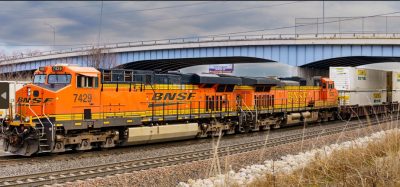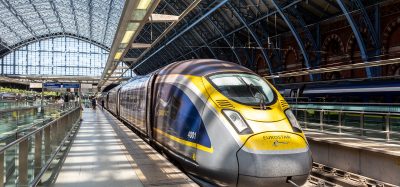The Italian railway network looks to the future
Posted: 4 August 2011 | | No comments yet
My last contribution to Global Railway Review was back in Issue 4 2008, when I was interviewed about the then current status and view of high-speed operations in Italy. Since then Italy has changed a great deal where infrastructure is concerned.
The Italian High-Speed/High-Capacity (HS/HC) network
Today, Italy is a more modern and better connected country. The completion of the Turin–Milan–Rome–Naples–Salerno High- Speed/High-Capacity network in 2009 triggered a far-reaching revolution in the national transport sector and gave a strong boost to the economic, cultural and social life of the country, taking Italy to the highest European levels. With its 1,000km of dedicated tracks, the HS/HC network is the most important infrastructure to be built in Italy since the end of the Second World War, and has made it possible to make the railway benefit not only customers wishing to travel more quickly for work or leisure, but also for commuter and goods traffic.
My last contribution to Global Railway Review was back in Issue 4 2008, when I was interviewed about the then current status and view of high-speed operations in Italy. Since then Italy has changed a great deal where infrastructure is concerned. The Italian High-Speed/High-Capacity (HS/HC) network Today, Italy is a more modern and better connected country. The completion of the Turin–Milan–Rome–Naples–Salerno High- Speed/High-Capacity network in 2009 triggered a far-reaching revolution in the national transport sector and gave a strong boost to the economic, cultural and social life of the country, taking Italy to the highest European levels. With its 1,000km of dedicated tracks, the HS/HC network is the most important infrastructure to be built in Italy since the end of the Second World War, and has made it possible to make the railway benefit not only customers wishing to travel more quickly for work or leisure, but also for commuter and goods traffic.
My last contribution to Global Railway Review was back in Issue 4 2008, when I was interviewed about the then current status and view of high-speed operations in Italy. Since then Italy has changed a great deal where infrastructure is concerned.
The Italian High-Speed/High-Capacity (HS/HC) network
Today, Italy is a more modern and better connected country. The completion of the Turin–Milan–Rome–Naples–Salerno High- Speed/High-Capacity network in 2009 triggered a far-reaching revolution in the national transport sector and gave a strong boost to the economic, cultural and social life of the country, taking Italy to the highest European levels. With its 1,000km of dedicated tracks, the HS/HC network is the most important infrastructure to be built in Italy since the end of the Second World War, and has made it possible to make the railway benefit not only customers wishing to travel more quickly for work or leisure, but also for commuter and goods traffic. To fully highlight the importance of this network it must be seen from a nationwide point-of-view: the HS/HC network, in fact, joins the country from North to South, like a rapid metro, crossing the Apennines and covering an area where – according to Unesco – half the world’s artistic heritage is located and where 65% of national employment and mobility is concentrated. It should also be pointed out that the high-speed network is the outcome of the intelligence and work of Italian companies and that in 2010 alone it attracted approximately 55% of people travelling between Rome and Milan, taking passengers off planes and out of cars. This benefits the environment and improves the quality of life for all, given that the train is the least polluting engine-powered means of transport.
Development of infrastructure
Now the Italian HS/HC network has been completed, the attention of Rete Ferroviaria Italiana (RFI) – the infrastructure company of the Italian Ferrovie dello Stato (FS) Group has turned to the large urban junctions where commuter traffic is concentrated (for example in Rome, Milan, Naples and the Veneto area) and to the completion of the HS/HC system towards the East and South of Salerno, towards Sicily. In order to ensure the fluidity of traffic flows and to optimise circulation in the crucial centres of the country’s economy and recovery, RFI is building new stretches of lines whilst boosting the infrastructural capacity of the network. For example, work has already started on the new Arcisate–Stabio line (over 11km) between Italy and Switzerland which will be operational in 2013. On 13th June 2011, a tender was announced for quadruplicating the line from Rho to Parabiago and the ‘Y’ link which will further improve connections with the international airport of Malpensa, thus connecting it both to the Italian HS/HC network and to Lugano, Mendrisio and, more in general, to the cities in southern and central Switzerland.
The Trans-European Transport Networks (TEN-T) which involve Italy are also at a good stage:
- Line 1: Berlin–Palermo railway axis
- Line 5: Lisbon–Kiev railway axis
- Line 24: Rotterdam–Genoa railway axis.
Most of the work on these three TEN–T networks has already been completed and now the missing segments are being built and existing connections boosted. In detail, for axis line 1, in April 2011, work began on the Brenner Base Tunnel and the projects to integrate the HS/HC connections to the South, with priority for the Salerno–Reggio Calabria (Ogliastro–Sapri variant) and Messina–Catania–Palermo itineraries, are currently being developed. As previously mentioned, the entire Milan – Bologna – Florence – Rome – Naples – Salerno HS/HC network and the Bologna–Verona double-track line are already working. For axis line 5, work began on La Maddalena (Chiomonte) descending shaft at the end of June 2011 and discussions are being held concerning the Brescia–Padova and the Venice–Trieste lines. In March 2011, a rail yard opened for the Treviglio–Brescia stretch, which will be completed by 2015, while the Turin–Milan–Treviglio and Padova–Venice HS/HC lines are already working. Axis line 24 (which links the Mediterranean to the North Sea) is a major project in Italy and includes the socalled Terzo Valico dei Giovi pass which is approximately 20% of the whole axis, for which the CIPE (Interministerial Committee for Economic Planning) approved the first building lot on 6th November 2010.
RFI is also performing ‘light’ work (organisational and technological) in goods terminals and ports.
New high-speed stations
Sticking with the topic of infrastructure, many important targets will be reached in 2011. RFI owns all the Italian terminals and new highspeed stations will also be completed in 2011, incorporating cutting-edge structures designed by worldwide famous contract-winning architects. The new high-speed stations – no longer designed as simple transit points but as meeting places and cultural spaces – enter the urban tissue as privileged access points to towns and to ease the fluidity of rail traffic by further accelerating it. The stations of Torino Porta Susa and Roma Tiburtina will be finished during 2011. Roma Tiburtina station is already partially activated and open to the public, and will be dedicated to Camillo Benso, Count of Cavour, in October 2011; while at Torino Porta Susa, the metro link will be inaugurated in summer 2011. The underground high-speed station of Bologna and Napoli Afragola, both currently at an advanced stage of completion, will be opened in the summer of 2012 while the underground station of Firenze Belfiore, where work has already begun, will be completed in 2015.
Liberalisation in the railway market
We are fast approaching 2012, the year in which the Italian railway market – already one of the most open and competitive in Europe – will take a further step forwards with regards to the liberalisation of the sector. It should be remembered that RFI, the network owner and therefore the subject that allocates time slots to the railway companies managing traffic capacity on the entire national network, has an Executive Committee wholly independent and separate from Trenitalia, the Italian FS Group company that is responsible for transport, in order to guarantee fair and non-discriminatory conditions for all companies in the sector requesting access to the Italian railway network. At the time of publication of this issue, 47 companies hold railway licences issued by the Ministry of Infrastructure and Transport. Of these, just 32 (including Trenitalia) are operative, that is, they also hold safety certificates issued by the National Railway Safety Agency (ANSF). Just over half (17) have acquired time slots for goods traffic only. Seven are foreign or mixed-capital companies. Others operate in the passenger sector, both regional (with public capital: TRENORD and FER, just to mention few) and at market (Arenaways). In 2012, with the arrival of NTV (an Italian-French capital company) on the high-speed lines, the Italian market will be the first in Europe to have all its services liberalised. With regards to regulatory aspects, with its Network Information Statement (PIR) RFI has covered various areas that were not yet regulated, as concerns the procedure of allocating infrastructure capacity and rules for the production and purchase of railway services. In many European countries, for example, railway companies must have safety certificates before they can request time slots. On the contrary, in Italy, until the recent publication of the extraordinary updated PIR, companies were allowed to book time slots by simply requesting the safety certificate, with the paradoxical result that RFI was obliged to ‘block’ time slots even if it was not sure if they could be used. Now, with the modification recently proposed by RFI and approved by the Italian Rail Regulatory Body (URSF), the national procedure approaches that of other European countries, even if still more restrictive. In Italy, the safety certificate is not required before time slots can be requested, even though it must be submitted within four months from the request. Given that beforehand it could be presented just before activating services, it is an improvement that is consistent with the safety certificate issue times established in Legislative Decree 162/2007 and in ANSF procedures. However, it is time for us to keep on asking the EU for more clarity and rules that are the same for all.
Technology and safety
In the railway sector, the technological supremacy of Italy is recognised all over the world. Indeed confirmation of this came from the European Union which adopted the ERTMS/ETCS level 2 (European Railway Traffic Management System/European Train Control System), that is the safety system used by RFI on the Italian high-speed network, as European standard in order to assure interoperability between the various national networks. On the other hand safety is one of the distinctive features not only of the high-speed network, but also of the entire Italian railway structure. Thanks to the new technologies installed – especially the ERTMS/ETCS, but also the Automatic Train Protection National System (ATPNS, SCMT in Italy) and the Automatic Train Protection – Low traffic lines – National System (ATPLNS, SSC in Italy) – the Italian network is the first in the world to be totally protected against human error. And the results are there for all to see: the number of ‘typical’ accidents has constantly fallen over the last two decades. In Italy – according to UIC1 data – the number of accidents fell by a good 85% between 2004 and 2010. These are significant results, together with the prestigious international awards received by RFI for the excellence of the technologies developed and implemented on the Italian network, have allowed the Italian FS Group to consolidate and expand its presence in other countries. The Mediterranean, the Middle East, Eastern Europe, the Balkans, Latin America and the USA are now the main areas in which Italian Railways operates, exporting Italian excellence in order to develop the railway networks in those countries.
Multifunctional railway portals
Along with the above achievements, RFI is also testing new technologies such as multifunctional railway portals. The project involves installing railway systems along some stretches of line that can ‘scan’ the trains as they pass by in order to identify potential dangers before the trains reach any ‘critical’ areas of the infrastructure, such as one of the many long tunnels along the Italian network. Known abroad with the acronym WTMS (Wayside Train Monitoring Systems), the multifunctional railway portals can analyse heat (and other parameters) and recognise non-standard ‘profiles’. Seeing the tortuous orography of Italy, they are extremely useful. For example, 93% of the Bologna–Florence HS line runs in tunnel. At the moment, three multifunctional railway portals are being tested on the national network: the first, at Rastignano on the Bologna–Florence (traditional line), near the long Apennine tunnel, was completed in 2007 and is a first-generation portal; while the other two, on the Rome–Naples (via Formia) line, between Priverno and Minturno, are based on a much more evolved technology and have been at an advanced testing stage for about a year, with operators examining the findings 24 hours a day. About one and a half million vehicles have been analysed by the second-generation multifunctional railway portals while they were travelling and with no limits to speed. The results show that they automatically recognise the trains in transit, identifying them and classifying them into the relative typologies (locomotives, carriages, wagons, etc.). The sophisticated equipment is also extremely good at detecting thermal anomalies (such as braked wheels or insufficiently cooled rheostats), as well as any ‘out-of-profile’ problems (such as projecting loads, flapping tarpaulins, incorrectly closed doors).
At the moment, the Technical Management of RFI is planning the installation of thirdgeneration multifunctional railway portals which, compared with those tested up until now, will be based on SIL 4 technology (maximum safety level) and can be interfaced with signalling equipment. Seven of these will shortly be installed on the boundary lines. In overall terms, by the end of the project, about one hundred will be scattered on the entire network. Testing has almost been completed and by the end of 2011, Rete Ferroviaria Italiana will issue the regulations for making the installed systems fully operative.
Reference
1. The International Railway Union (UIC) is the global organisation for international co-operation between railways and the promotion of railway transport at global level.
About the Author
Michele Mario Elia is an electro-technical engineer and has worked in the Ferrovie dello Stato Group since 1975. Since September 2006, he has been Chief Executive Officer of RFI – the Italian Railway Network Company of FS Group – the same society where he was Technical Director from 1998 to 2006. He has also been Chairman of the UIC ERTMS Platform/CCS & Operation Sector since June 2007 and, from October 2007, Chairman of TAV (High-Speed company of the FS Group). Since October 2009, he has also been a member of the ERA Administrative Board.








